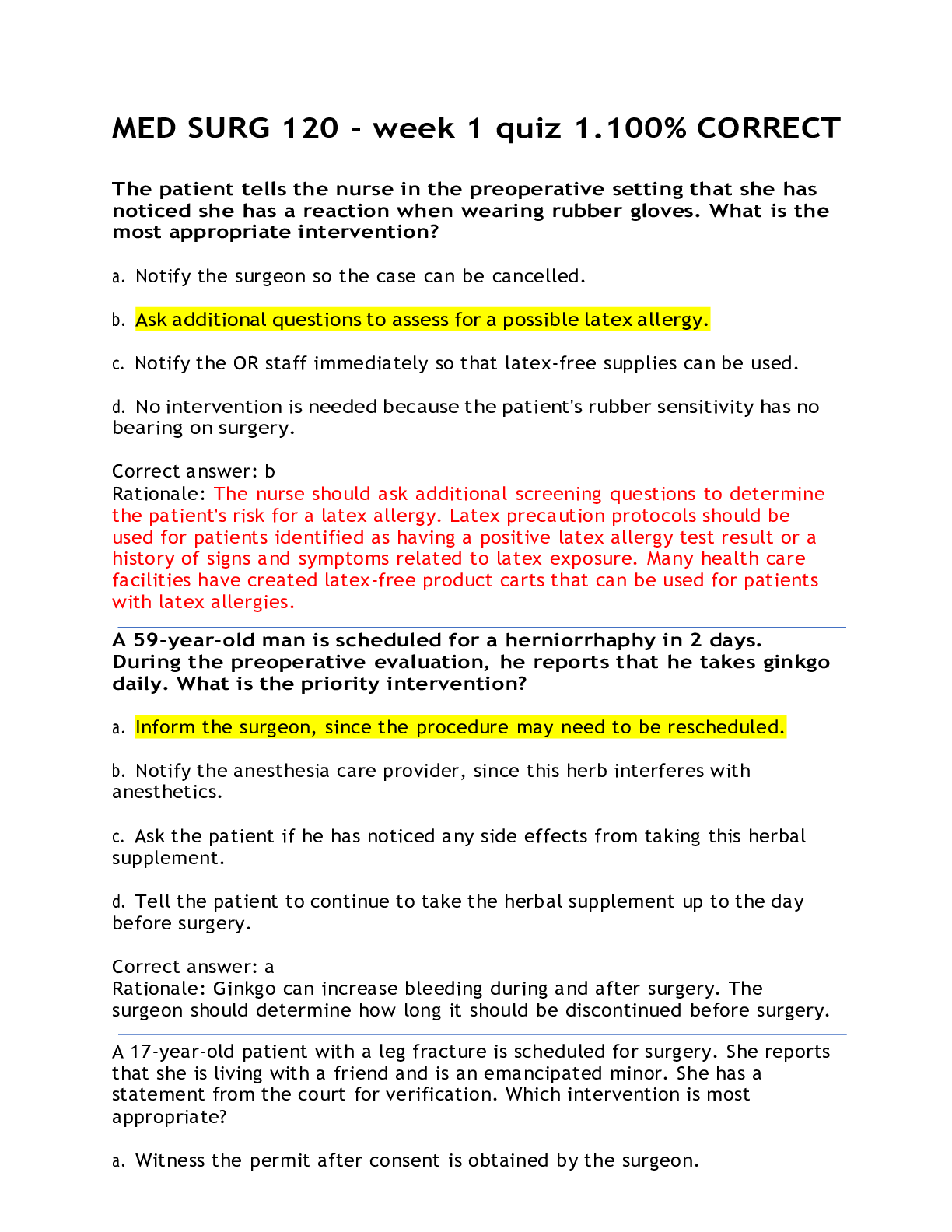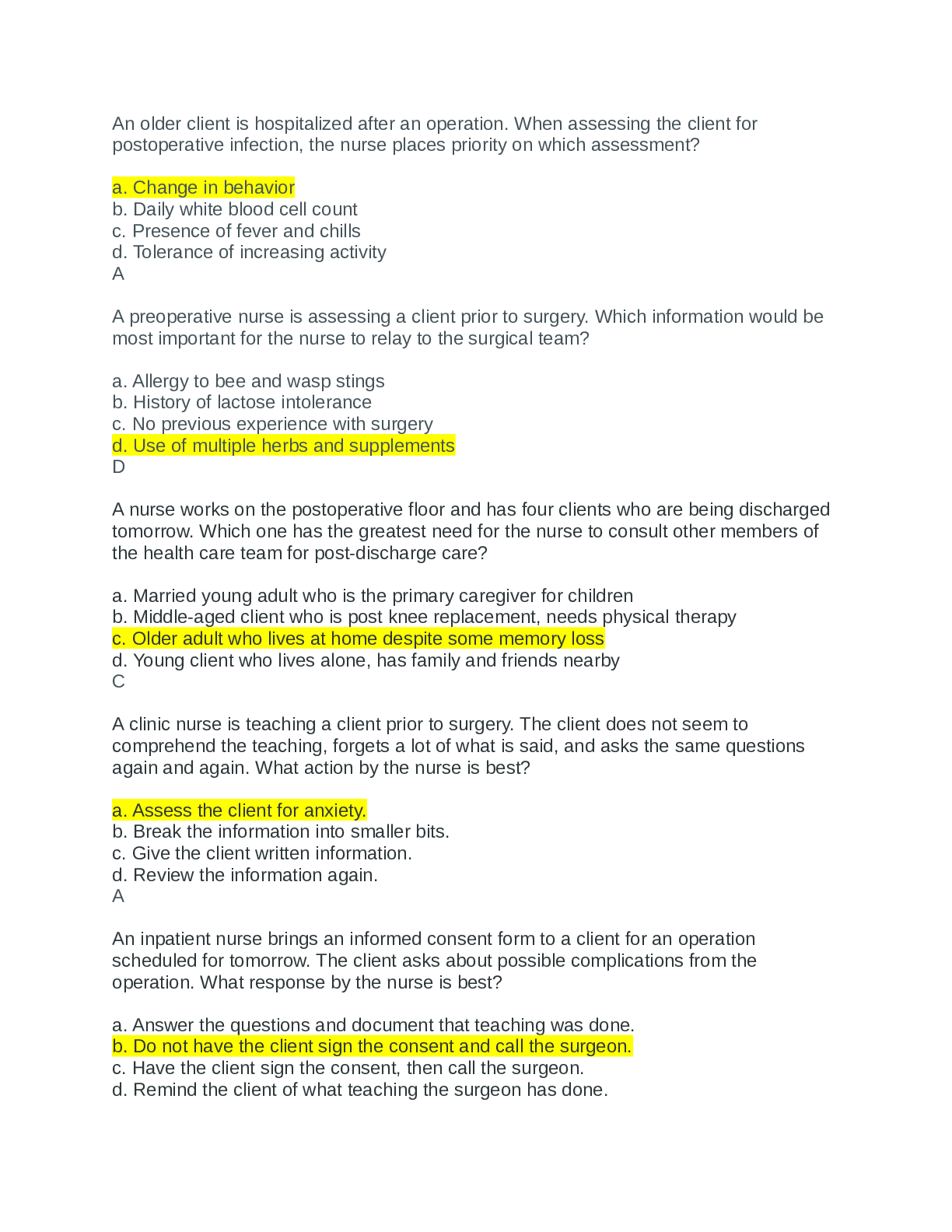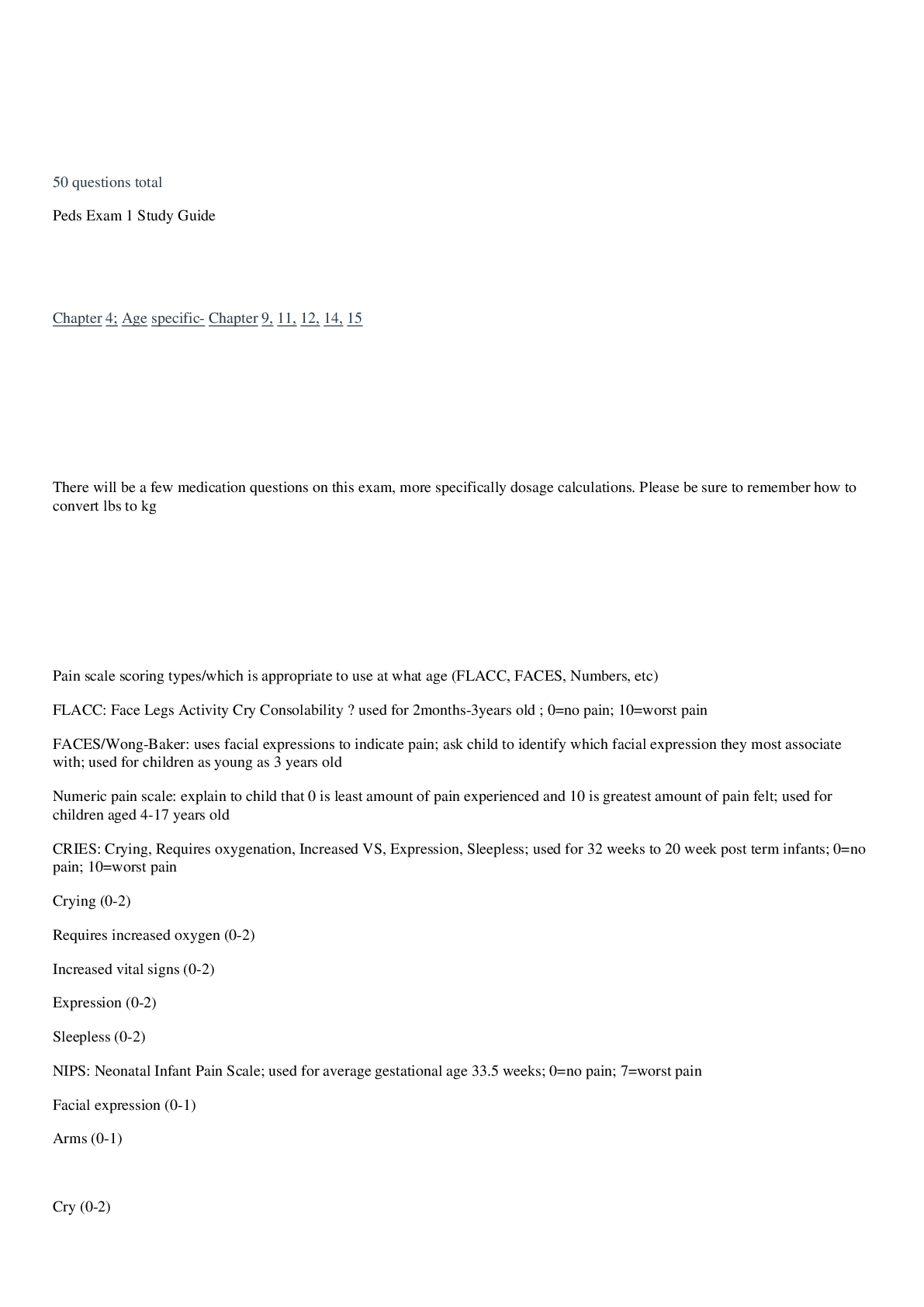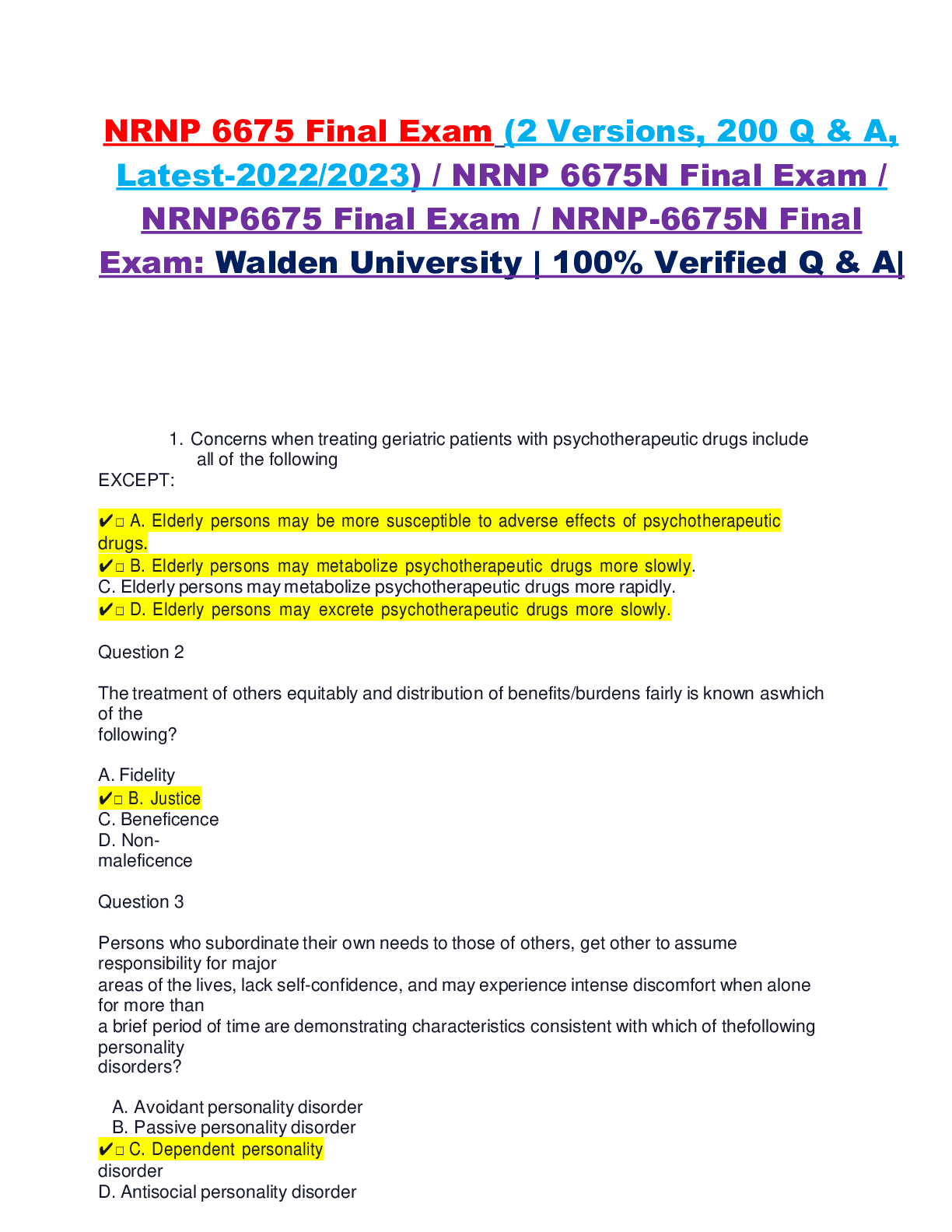MED SURG 120 - week 1 quiz 1.100% CORRECT
Document Content and Description Below
MED SURG 120 - week 1 quiz 1.100% CORRECTMED SURG 120 - week 1 quiz 1.100% CORRECT The patient tells the nurse in the preoperative setting that she has noticed she has a reaction when wearing rubber ... gloves. What is the most appropriate intervention? a. Notify the surgeon so the case can be cancelled. b. Ask additional questions to assess for a possible latex allergy. c. Notify the OR staff immediately so that latex-free supplies can be used. d. No intervention is needed because the patient's rubber sensitivity has no bearing on surgery. Correct answer: b Rationale: The nurse should ask additional screening questions to determine the patient's risk for a latex allergy. Latex precaution protocols should be used for patients identified as having a positive latex allergy test result or a history of signs and symptoms related to latex exposure. Many health care facilities have created latex-free product carts that can be used for patients with latex allergies. A 59-year-old man is scheduled for a herniorrhaphy in 2 days. During the preoperative evaluation, he reports that he takes ginkgo daily. What is the priority intervention? a. Inform the surgeon, since the procedure may need to be rescheduled. b. Notify the anesthesia care provider, since this herb interferes with anesthetics. c. Ask the patient if he has noticed any side effects from taking this herbal supplement. d. Tell the patient to continue to take the herbal supplement up to the day before surgery. Correct answer: a Rationale: Ginkgo can increase bleeding during and after surgery. The surgeon should determine how long it should be discontinued before surgery. A 17-year-old patient with a leg fracture is scheduled for surgery. She reports that she is living with a friend and is an emancipated minor. She has a statement from the court for verification. Which intervention is most appropriate? a. Witness the permit after consent is obtained by the surgeon. b. Call a parent or legal guardian to sign the permit, since the patient is under 18. c. Obtain verbal consent, since written consent is not necessary for emancipated minors. d. Investigate your state's nurse practice act related to emancipated minors and informed consent. Correct answer: a Rationale: An emancipated minor may sign his or her own permit. The nurse should be available to witness the signature, but no further action is required. A priority nursing intervention to assist a preoperative patient in coping with fear of postoperative pain would be to a. informs the patient that pain medication will be available. b. teach the patient to use guided imagery to help manage pain. c. describe the type of pain expected with the patient's particular surgery. d. explain the pain management plan, including the use of a pain rating scale. Correct answer: d Rationale: If a patient has fear of pain and discomfort after surgery, the nurse should reassure the patient that a pain management plan will be in place. The nurse should teach the patient to ask for medications after surgery when pain is present and assure him or her that taking these medications will not contribute to an addiction. The nurse should instruct the patient on the use of some form of pain rating scale (e.g., 0 to 10, FACES) and to request pain medication before the pain becomes severe. A patient is scheduled for surgery requiring general anesthesia at an ambulatory surgical center. The nurse asks him when he ate last. He replies that he had a light breakfast a couple of hours before coming to the surgery center. What should the nurse do first? a. Tell the patient to come back tomorrow, since he ate a meal. b. Proceed with the preoperative checklist, including site identification. c. Notify the anesthesia care provider of when and what the patient last ate. d. Have the patient void before administering any preoperative medications. Correct answer: c Rationale: The nothing-by-mouth (NPO) protocol of each surgical facility should be followed. Restriction of fluids and food is designed to minimize the potential risk of pulmonary aspiration and to decrease the risk of postoperative nausea and vomiting. If a patient has not followed the NPO instructions, surgery may be delayed or canceled. The nurse should notify the anesthesia care provider immediately. A patient who normally takes 40 units of glargine insulin (long acting) at bedtime asks the nurse what to do about her dose the night before surgery. The best response would be to have her a. skip her insulin altogether the night before surgery. b. take her usual dose at bedtime and eat a light breakfast in the morning. c. eat a moderate meal before bedtime and then take half her usual insulin dose. d. get instructions from her surgeon or health care provider on any insulin adjustments. Correct answer: d Rationale: Insulin is not usually omitted completely. The patient should obtain instructions from her health care provider or surgeon about any dosage adjustments that she should make the day before and the morning of surgery (if applicable). Preoperative considerations for older adults include (select all that apply) a. only using large-print educational materials. b. speaking louder for patients with hearing aids. c. recognizing that sensory deficits may be present. d. providing warm blankets to prevent hypothermia. e. teaching important information early in the morning. Correct answers: c, d Rationale: Many older adults have sensory deficits. Preoperative and operating rooms are cool; warm blankets should be provided as needed. Proper attire for the semi-restricted area of the surgery department is a. street clothing. b. surgical attire and head cover. c. surgical attire, head cover, and mask. d. street clothing with the addition of shoe covers. Correct answer: b Rationale: The semi-restricted area includes the surrounding support areas and corridors. Only authorized staff members are allowed access to the semi- restricted areas. All staff in the semi-restricted area must wear surgical attire and cover all head and facial hair. Activities that the nurse might perform in the role of a scrub nurse during surgery include (select all that apply) a. checking electrical equipment. b. preparing the instrument table. c. passing instruments to the surgeon and assistants. d. coordinating activities occurring in the operating room. e. maintaining accurate counts of sponges, needles, and instruments. Correct answers: b, c, e Rationale: Maintaining accurate counts of sponges, needles, and instruments is a shared responsibility of the scrub nurse and circulating nurse. (Note: It is listed as an activity for both in Table 19-1.) The nurse is caring for a patient undergoing surgery for a knee replacement. What is critical to the patient's safety during the procedure (select all that apply)? a. Universal protocol is followed. b. The ACP is an anesthesiologist. c. The patient has adequate health insurance. d. The circulating nurse is a registered nurse. e. The patient's allergies are conveyed to the surgical team. Correct answers: a, e Rationale: Intra-operative nursing care includes determining the patient's allergy status in response to food, drugs, and latex. Preventing use of the wrong site, wrong procedure, and wrong surgery has become known as the Universal Protocol. The Universal Protocol is part of a global patient safety initiative. The nurse's primary responsibility for the care of the patient undergoing surgery is a. developing an individualized plan of nursing care for the patient. b. carrying out specific tasks related to surgical policies and procedures. c. ensuring that the patient has been assessed for safe administration of anesthesia. d. performing a preoperative history and physical assessment to identify patient needs. Correct answer: a Rationale: A primary role of the nurse is to assess the patient to develop an individual plan of care. When scrubbing at the scrub sink, the nurse should a. scrub from elbows to hands. b. scrub without mechanical friction. c. scrub for a minimum of 10 minutes. d. hold the hands higher than the elbows. Correct answer: d Rationale: To perform a surgical scrub, the fingers and hands should be scrubbed first, progressing to the forearms and elbows. The hands should be held away from surgical attire and higher than the elbows at all times to prevent contamination from clothing or from detergent suds and water draining from the unclean area above the elbows to the clean and previously scrubbed areas of the hands and fingers. When positioning a patient in preparation for surgery, the nurse understands that injury to the patient is most likely to occur as a result of a. incorrect musculoskeletal alignment. b. loss of perception of pain or pressure. c. pooling of blood in peripheral vessels. d. disregarding the patient's need for modesty. Correct answer: a Rationale: Whatever position is required for the procedure; great care is taken to prevent injury to the patient. Because anesthesia blocks the sensory nerve impulses, the patient does not feel pain or discomfort or sense stress placed on the nerves, muscles, bones, and skin. Improper positioning can result in muscle strain, joint damage, pressure ulcers, nerve damage, and other untoward effects. Intravenous induction for general anesthesia is the method of choice for most patients because a. the patient is not intubated. b. the agents are nonexplosive. c. induction is rapid and pleasant. d. emergence is longer but with fewer complications. Correct answer: c Rationale: Routine general anesthesia is usually established with an intravenous (IV) induction agent, which may be a hypnotic, anxiolytic, or dissociative agent. When used during the initial period of anesthesia, these agents induce a pleasant sleep with a rapid onset of action that patients find desirable. When a patient is admitted to the PACU, what are the priority interventions the nurse performs? a. Assess the surgical site, noting presence and character of drainage. b. Assess the amount of urine output and the presence of bladder distention. c. Assess for airway patency and quality of respirations, and obtain vital signs. d. Review results of intraoperative laboratory values and medications received. Correct answer: c Rationale: Assessment in the post-anesthesia care unit (PACU) begins with evaluation of the airway, breathing, and circulation (ABC) status of the patient. Identification of inadequate oxygenation and ventilation or respiratory compromise necessitates prompt intervention. A patient is admitted to the PACU after major abdominal surgery. During the initial assessment, the patient tells the nurse he thinks he is going to "throw up." A priority nursing intervention would be to a. increase the rate of the IV fluids. b. obtain vital signs, including O2 saturation. c. position patient in lateral recovery position. d. administer antiemetic medication as ordered. Correct answer: c Rationale: If the patient is nauseated and may vomit, place the patient in a lateral recovery position to keep the airway open and reduce the risk of aspiration if vomiting occurs. After admission of the postoperative patient to the clinical unit, which assessment data require the most immediate attention? a. Oxygen saturation of 85% b. Respiratory rate of 13/min c. Temperature of 100.4° F (38° C) d. Blood pressure of 90/60 mm Hg Correct answer: a Rationale: During the initial assessment, identify signs of inadequate oxygenation and ventilation. Pulse oximetry monitoring is initiated because it provides a noninvasive means of assessing the adequacy of oxygenation. Pulse oximetry may indicate low oxygen saturation (<90% to 92%) with respiratory compromise. This necessitates prompt intervention A 70-kg postoperative patient has an average urine output of 25 mL/hr during the first 8 hours. The priority nursing intervention(s) given this assessment would be to a. perform a straight catheterization to measure the amount of urine in the bladder. b. notify the physician and anticipate obtaining blood work to evaluate renal function. c. continue to monitor the patient because this is a normal finding during this time period. d. evaluate the patient's fluid volume status since surgery and obtain a bladder ultrasound. Correct answer: d Rationale: Because of the possibility of infection associated with catheterization, the nurse should first try to validate that the bladder is full. The nurse should consider fluid intake during and after surgery and should determine bladder fullness by percussion, by palpation, or by a portable bladder ultrasound study to assess the volume of urine in the bladder and avoid unnecessary catheterization. Normal u/o=60 mL/hr Discharge criteria for the Phase II patient include (select all that apply) a. no nausea or vomiting. b. ability to drive self-home. c. no respiratory depression. d. written discharge instructions understood. e. opioid pain medication given 45 minutes ago. Correct answers: c, d, e Rationale: Phase II discharge criteria that must be met include the following: all PACU discharge criteria (Phase I) met; no intravenous opioid drugs administered for the past 30 minutes; patient's ability to void (if appropriate with regard to surgical procedure or orders); patient's ability to ambulate if it is not contraindicated; presence of a responsible adult to accompany or drive patient home; and written discharge instructions given and understood. A patient becomes restless and agitated in the PACU as he begins to regain consciousness. The first action the nurse should take is to: a. turn the patient to a lateral position b. orient the patient and tell him that the surgery is over c. administer the ordered post-op pain medications d. check the patient’s oxygen saturation with pulse oximetry Correct answer: d Rationale: This patient is experiencing a respiratory complication post-op-- > Hypoxemia is a partial pressure of arterial oxygen (PaO2) less than 60 mmHG, and is characterized by s/s including agitation to somnolence, hypertension to hypotension and tachycardia to bradycardia. Pulse ox will be 90-92%. Atelectasis (alveolar collapse) or pulmonary edema (fluid accumulation in the alveoli) may cause hypoxemia. this answer has to do with ASSESSING the patient!!!!! During administration of the patient to the holding area or operating room before surgery, the peri-operative nurse must: a. verify the patient's understanding of the risks of surgery b. ensure the patient's identity with a formal ID process c. prepare the skin by scrubbing the surgical site with an anti-microbial agent d. perform a pre-operative assessment with a patient history and physical exam Correct answer: B Rationale: This question is testing whether or not you understand what the peri-op nurse does, and understand what the purpose of the holding area is. It is the job of the peri-op nurse to: -prepare the room with the team -serve as patient advocate through surgical experience -maintain patient safety, privacy, dignity and confidentiality. The purpose of the holding area is: -verification of relevant documentation: H&P, signed consent form, nursing and pre-anesthesia assessment -required blood products and equipment -diagnostic radiology tests labeled (xrays, labs) -Procedure site mark Answer 'a' should have been done during the pre-op assessment Answer 'c' is done after the patient is verified and is in the OR Answer 'd' should have been done either earlier that day, or the day before While in the PACU, the patient's BP drops from an admission pressure of 126/82 to 106/78 with a pulse change of 70 to 94. The nurse administers oxygen and then: a. increases the rate of the IV fluids b. notifies the anesthesia care provider c. performs neurovascular checks on the lower extremities d. uses a cardiac monitor to assess the patients heart rhythm Correct answer: a Rationale: this patient is hypovolemic and their body is therefore compensating with an increasing HR to circulate the blood, but a decreased BP due to lack of fluid in vascular circulation. Remember, with these questions, assume the patient already has an IV started and has fluids running; aka, assume the answers are all options available to you. The order of priority would therefore be: a, b, d, c The nurse is preparing to discharge a patient from the ambulatory surgery center following an inguinal hernia repair. The nurse delays the release of the patient upon discovering that the patient: a. had IV morphine 45 minutes ago b. has an oxygen saturation of 92% c. has not voided since before surgery d. had one episode of vomiting 30 minutes ago Correct answer: c Rationale: The patient has to void before going home! Not voiding may indicate a myriad of problems such as: kidney injury, dehydration, loss of sensation, or may lead to a UTI. Remember that a patient who is given morphine only has to be watched for the first 15 minutes A 68-year-old male scheduled for a herniorrhaphy at an ambulatory surgical center expresses concern that he will not have enough care at home and asks if he can stay in the hospital after surgery. The best response by the nurse is: a. "Who is available to help you at home after surgery?" b. "I'm sure you will be able to manage at home after surgery. It is a simple procedure" c. "We will teach you everything you need to know to be able to care for yourself after surgery" d. "Your health insurance will pay for inpatient care only if complications develop during surgery" Correct answer: a Rationale: find out more information through subjective assessment. Don't assume anything, and learn about the resources available for the patient Preoperative instruction that is appropriate for all patients includes: a. techniques of deep breathing and coughing b. descriptions of the planned surgical procedure c. physical procedures or preparation required before surgery d. withholding of all oral fluids or food after midnight on the day of surgery Correct Answer: C a & b are before preoperative d- not all pts are NPO Which of the following is the primary reason for accurately recording the patient's current medications during a preoperative assessment? a. some medications may alter the patient's perceptions about surgery b. many anesthetics alter renal and hepatic function, causing toxicity of other drugs c. some medications may interact with anesthetics, altering the potency and effect of the drugs d. routine medications are withheld the day of surgery, requiring dosage and schedule adjustments after surgery Correct Answer: C The nurse is admitting a patient to the same-day surgery unit. The patient tells the nurse that he was so nervous he had to take kava last night to help him sleep. Which of the following nursing actions would be most appropriate? a. tell the patient that using kava to help sleep is often helpful b. inform the anesthesiologist of the patient's recent use of kava c. tell the patient that the kava should continue to help him relax before surgery d. inform the patient about the dangers of taking herbal medicines without consulting his health care provider Correct Answer: B Preoperative nursing assessment data that should be collected reaction/problems to anesthesia (Patient or family) current medications allergies (drug & nondrug) screen for latex allergy (kiwi allergy = risk factor) CV system (presence of pacemaker/ICD) Note problems voiding, inform operative team Report problems r/t neck/spine to anesthesia care provider monitor BS in DM patients morning of surgery While performing preoperative teaching, the patient asks when she needs to stop drinking water before surgery. Based on the most recent practice guidelines established by the American Society of Anesthesiologists, the nurse tells the patient that a. she must be NPO after breakfast b. she needs to be NPO after midnight c. she can drink clear liquids up to 2 hours before surgery d. she can drink clear liquids up until she is moved to the OR Correct Answer: C Five minutes after receiving a preoperative sedative medication by IV injection, a patients asks to get up to go to the bathroom to urinate. Which of the following is the most appropriate action for the nurse to take? a. offer the patient to use the bedpan/urinal after explaining the need to maintain safety b. assist the patient to the bathroom and stay next to the door to assist patient back to bed when done c. allow the patient to go to the bathroom since the onset of the medication will be more than 5 minutes d. ask the patient to hold the urine for a short period of time since the urinary catheter will be inserted in the OR Correct Answer: A What is included in the surgical care improvement project (SCIP) that should occur in the holding area of the OR? patient warming prophylactic antibiotic administration application of sequential compression devices During admission of the patient to the holding area of the OR before surgery, the perioperative nurse must a. verify the patient's understanding of the risks of the surgery b. ensure the patient's identity through a formal identification process c. prepare the skin by scrubbing the surgical site with an antimicrobial agent d. perform a preoperative assessment with a patient history and physical examination Correct Answer: B What is the universal protocol for promoting safety in the OR? eliminate wrong site/procedure/surgery (perform time-out) What is the initial assessment the nurse should assess in the PACU physical needs (VS monitoring) airway patency pulse oximetry ECG monitoring The nurse is working on a surgical floor and is preparing to receive a postoperative patient from the PACU. Which of the following should be the nurse's initial action upon the patient's arrival? a. assess the patient's pain b. assess the patient's vital signs c. check the rate of the IV infusion d. check the physician's postoperative orders Correct Answer: B Potential respiratory problems post-op airway obstruction hypoxemia atelectasis pulmonary edema aspiration of gastric contents bronchospasm Nursing interventions post-op respiratory management proper positioning to facilitate respirations and protect airway provide O2 therapy encourage deep breathing teach coughing techniques provide adequate and regular analgesics prior to cough, turn, deep breathe if needed A patient becomes restless and agitated in the PACU as he begins to regain consciousness. The first action the nurse should take is a. turn the patient to a lateral position b. orient the patient and tell him that the surgery is over c. administer the ordered post-op pain medication d. check the patient's oxygen saturation with pulse ox Correct Answer: D Nursing interventions post-op neuro management attention of evaluation of respiratory function sedation may be beneficial for controlling agitation/providing safety side rails up secure IV lines and artificial airways monitor physiologic status Nursing interventions post-op temperature management passive rewarming raises basal metabolism active rewarming requires application of warming devices monitor body temp at 30 min intervals Nursing interventions post-op GI management fluid/electrolyte imbalance hiccoughs N/V (antiemetics, oral fluids as tolerated, suction at bedside) abdominal distention (early and frequent ambulation, encourage pt to expel gas, position pt on right side) Oliguria UOP too low accepted UOP = at least 30mL/hr The nurse is preparing to discharge a patient from the ambulatory surgery center following an inguinal hernia repair. The nurse delays release of the patient upon discovering that the patient a. had IV morphine 45 min ago b. has an O2 sat of 92% c. has not voided since before surgery d. had one episode of vomiting 30 minutes ago Correct Answer: C [Show More]
Last updated: 1 year ago
Preview 1 out of 15 pages

Reviews( 0 )
Document information
Connected school, study & course
About the document
Uploaded On
Jan 14, 2023
Number of pages
15
Written in
Additional information
This document has been written for:
Uploaded
Jan 14, 2023
Downloads
0
Views
41






.png)



























